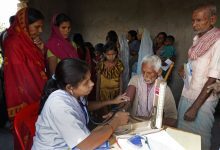Finance Minister Arun Jaitley, presenting the last full budget of Modi government before it goes to polls in May next year, announced a game-changing health insurance scheme to 10 crores below poverty families, which translates to 50 crore persons. The scheme, dubbed as Modi-care, much bigger than Obamacare, proposed by then U.S. President for the health of its population, will bring a sea change in the healthcare of the population. Here’s an analysis, for Different Truths.
Stung by the India shining campaign of ruling NDA in 2004, which did not go well with rural India and hence defeated in the elections, Prime Minister Narendra Modi’s government has come out with an election budget that brings cheers to struggling Bharat, hit by farm distress and the collapse of informal sector in rural economy.
 Finance Minister Arun Jaitley, presenting the last full budget of Modi government before it goes to polls in May next year, announced a game-changing health insurance scheme to 10 crores below poverty families, which translates to 50 crore persons. The scheme, dubbed as Modi-care, much bigger than Obamacare, proposed by then U.S. President for the health of its population, will bring a sea change in the healthcare of the population. The details of the scheme with a component from states is yet to be worked out but aims to provide up to Rs 5 lakh cashless hospitalisation per year to all members of 10 crores below poverty line families. This will help in moving towards universal healthcare after food security was implemented a few years ago. Of course, it is not going to be easy to roll out just as food security programme, which took some years and a lot of money from the exchequer. But it was ultimately implemented for the betterment of people. Likewise, this healthcare programme might take some time to roll out but augurs well for the people. Health and education are two areas where the government has to do a lot more even though some efforts have been made by successive governments. This healthcare effort of Modi government is one revolutionary step that stands out in the budget that needed to be applauded.This move is something originally started by Tamil Nadu government some years back for up to Rs 2 lakh hospitalisation and has been implemented in a few other states over the years. So this scheme is implementable at the national level and on a larger scale.
Finance Minister Arun Jaitley, presenting the last full budget of Modi government before it goes to polls in May next year, announced a game-changing health insurance scheme to 10 crores below poverty families, which translates to 50 crore persons. The scheme, dubbed as Modi-care, much bigger than Obamacare, proposed by then U.S. President for the health of its population, will bring a sea change in the healthcare of the population. The details of the scheme with a component from states is yet to be worked out but aims to provide up to Rs 5 lakh cashless hospitalisation per year to all members of 10 crores below poverty line families. This will help in moving towards universal healthcare after food security was implemented a few years ago. Of course, it is not going to be easy to roll out just as food security programme, which took some years and a lot of money from the exchequer. But it was ultimately implemented for the betterment of people. Likewise, this healthcare programme might take some time to roll out but augurs well for the people. Health and education are two areas where the government has to do a lot more even though some efforts have been made by successive governments. This healthcare effort of Modi government is one revolutionary step that stands out in the budget that needed to be applauded.This move is something originally started by Tamil Nadu government some years back for up to Rs 2 lakh hospitalisation and has been implemented in a few other states over the years. So this scheme is implementable at the national level and on a larger scale.
Another significant measure in the budget is the impetus provided to the rural economy and address farm distress, which would be a force multiplier for overall growth expected to surge toward 8 percent annually. This would help India to become the fastest growing emerging economy, now at $2.5 trillion and expected to move two notches up in the coming months to overtake France and Britain to become fifth largest economy.
 Jaitley announced several measures to kick-start the rural economy now stumbling due to the twin structural reforms of demonetisation and GST in the last one a quarter year. The ill-effects of these two measures, though good, in the long run, has now been left behind. The measures including the decision to provide a 150 percent increase in minimum support price for the forthcoming Kharif crop, with a promise to ensure 1.5 times more farm income, will drive consumption in a big way, thereby helping the growth of related sectors.
Jaitley announced several measures to kick-start the rural economy now stumbling due to the twin structural reforms of demonetisation and GST in the last one a quarter year. The ill-effects of these two measures, though good, in the long run, has now been left behind. The measures including the decision to provide a 150 percent increase in minimum support price for the forthcoming Kharif crop, with a promise to ensure 1.5 times more farm income, will drive consumption in a big way, thereby helping the growth of related sectors.
The package of measures provided to pump-prime MSMEs through better access to finance or lowering of the corporate tax rate to 25 percent to companies having turnover up to Rs 250 crore would help to spur both employment and growth in this vital segment of the economy. MSMEs account for nearly 40 percent of manufacturing and 45 percent of exports in the country. It employs many times more compared to large industries, which are increasingly becoming capital intensive. The stress on jobs in the budget will help to generate meaningful employment going ahead. This will also help to solve the problem of disguised unemployment in the rural area.
Measures to step up irrigation, particularly minor irrigation and linking of peninsular rivers will bring more areas under irrigation. Though India has the largest irrigated area in the world, still only 45-50 percent of arable land in the country is irrigated. This augurs well for the rural economy as it is important to gradually minimise rain-fed farming, where yield is expected reduce over the years because of global warming, fragmentation of holding and so on.
 Critics may accuse Jaitley of presenting a populist budget in an election year but in reality, it is a very realistic budget addressing the areas of concern in the economy, which hitherto has been partially neglected. The government has rightly sought to take corrective steps and listen to the anger of the farmers and rural India.
Critics may accuse Jaitley of presenting a populist budget in an election year but in reality, it is a very realistic budget addressing the areas of concern in the economy, which hitherto has been partially neglected. The government has rightly sought to take corrective steps and listen to the anger of the farmers and rural India.
The Finance Minister also announced important measures to boost rural livelihoods. As Jaitley himself said in his 90-minute speech, the focus of the government next year will be on providing maximum livelihood opportunities in the rural areas by spending more on livelihood, agriculture and allied activities, and construction of rural infrastructure. The total amount to be spent by various ministries will be Rs.14.34 lakh crore, including extra-budgetary and non-budgetary resources of Rs.11.98 lakh crore.Apart from employment due to farming activities and self-employment, this expenditure will create employment of 321 crore person days, 3.17 lakh kilometers of rural roads, 51 lakh new rural houses, 1.88 crore toilets, and provide 1.75 crore new household electric connections besides boosting agricultural growth. Accordingly, the government substantially increased the allocation of National Rural Livelihood Mission to Rs. 5,750 crore in 2018-19. Loans to Self Help Groups (SHGs) of women has been increased to about Rs. 42,500 crore in 2016-17, growing 37% over the previous year.The government is confident that loans to SHGs will increase to Rs.75,000 crore by March 2019.
Strengthening the groundwater irrigation scheme under Prime Minister Krishi Sinchai Yojna – Har Khet ko Pani – the government allocated Rs 2,600 crore for this purpose. This would provide assured irrigation in 96 deprived irrigation districts where less than 30% of the land holdings get that presently.
Apart from keeping minimum support price for all hitherto unannounced crops of Kharif at least at one and a half times of their production cost, Jaitley raised farm credit to Rs.11 lakh crore for the year 2018-19 from Rs.10 lakh crore in 2017-18. He launched a new scheme ‘Operation Greens’ to address price volatility of perishable commodities like potatoes, tomatoes, and onions, at an outlay of Rs. 500 crore. Operation Greens, along with the lines of ‘Operation Flood’, shall promote Farmer Producers Organizations (FPOs), agri-logistics, processing facilities and professional management in the sector. Also, Jaitley announced 100 percent deduction of profit to farmers producer companies, having turnover up to Rs. 100 crore, for a period of 5 years from FY 2018-19, to encourage professionalism in post-harvest value addition in agriculture.
 Some 22,000 rural haats are to be developed and upgraded into Gramin Agricultural Markets to protect the interests of 86% small and marginal farmers.Two New Funds of Rs10,000 crore for fisheries and animal husbandry sectors are to be set up.Re-structured National Bamboo Mission is to Rs.129t0 crore.Development of bamboo will help in creating large-scale employment in the rural area. Loans to women self-help groups will increase to Rs.75,000 crore in 2019 from 42,500crore last year.
Some 22,000 rural haats are to be developed and upgraded into Gramin Agricultural Markets to protect the interests of 86% small and marginal farmers.Two New Funds of Rs10,000 crore for fisheries and animal husbandry sectors are to be set up.Re-structured National Bamboo Mission is to Rs.129t0 crore.Development of bamboo will help in creating large-scale employment in the rural area. Loans to women self-help groups will increase to Rs.75,000 crore in 2019 from 42,500crore last year.
Allocation to infrastructure has been stepped up to nearly Rs 6 lakh crore, which too will create rural jobs and development as most of the highways and railway lines pass through rural areas. The capital expenditure on Railways alone is 1.48 lakh crore and highways is a couple of lakhs of rupees. There is a huge allocation to rural roads as well.
Overall, one would not be wrong in saying that an honest attempt has been made to address the concerns of rural India, which had hitherto been neglected and hence the government had earlier received a tag of encouraging crony capitalism.
K R Sudhaman
©IPA Service
Photos from the Internet
#GovernmentOfIndia #FarmingAndAgriculture #Budget #FinanceMinister #Capitalism #RuralIndia #Obamacare #Modi #Railways #Funds #IPA #DifferentTruths






 By
By
